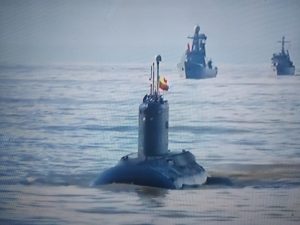The long-awaited transfer of a Russian-made Kilo-class submarine from India to Myanmar took place last week during Myanmar’s Bandoola fleet exercise. The submarine, UMS Min Ye Thein Kha Thu, a decades-old diesel boat, is only a single vessel but it has significance in Myanmar’s immediate neighborhood and is also indicative of the increasing strategic competition in the Indo-Pacific.
Obtaining the submarine is the realization of a long-held dream for Myanmar’s navy. Some reports indicate that Myanmar was in talks for the acquisition of submarines from the North Korean regime before 2002. Pakistan reportedly provided Burmese officers with submarine training in 2013, and the procurement of submarines was reportedly a topic of discussion when a high-level military delegation visited Russia in 2013. It might sound strange to hear that a navy without submarines was receiving training on them, but this would not be the first time a submarine force began to form without actually having any submarines. Thailand has maintained a submarine unit for years, and will likely receive the first of its Chinese-built submarines in 2023.
At the highest levels, this delivery brings into relief the competition for influence playing out at the confluence of South and Southeast Asia. With China providing submarines to Pakistan, Bangladesh and Thailand, India perceives pressure on its periphery. Provision of military equipment, particularly sophisticated systems like submarines, is not normally a one-time transaction. It is a long-term relationship that commonly involves further sales, training and exercises, and can often include long-term personnel exchanges. With its equipment sales to India’s neighbors, China has guaranteed itself enduring military access on India’s maritime borders.
Now China, long the main supplier of military equipment to Myanmar, has an expanding Indian toehold to reckon with. Indian trainers and maintenance personnel will need to visit Myanmar, and Myanmar will need to send sailors to India for continued training. The sailors in the submarine program will require English-language training, which India will provide and which will bind the two nations more closely together. A submariner corps trained in English is likely to continue seeking out training opportunities with English-speaking navies, particularly with the navy that provided its equipment and tactics.
At a more local level, Myanmar shares a hotly contested maritime border with Thailand, which is composed of several overlapping claims and has erupted in gunfire more than once. This dispute gives particular significance to the balance of maritime forces between the two neighbors. Initially contracted to purchase three Yuan-class submarines, Thailand appeared to have gained an edge in the contest between the two until the COVID-19 pandemic took a massive bite out of Thailand’s procurement plans. Steel had already begun to be cut in China for the first boat, but the purchase of the additional two submarines was delayed indefinitely following public outrage at the prioritization of new submarines over public health and pandemic resilience. Now Myanmar has turned the tables, and Thailand will be eager to restore the balance with the delivery of its first Yuan-class submarine in 2023.
Internally, the implications for Myanmar’s navy could be severe. One submarine is almost certainly a costly misstep that will be a drag on the navy’s budget for years to come. With a fleet that has only a half dozen surface combatants, freeing up enough sailors and maintenance personnel to properly operate and care for a sophisticated submarine will be a heavy burden. It must be remembered that a single boat is not a reliable operational capability. At best, it is useful as part of a “fleet in being” strategy, wherein the potential threat of the submarine, rather than its actual operational impact, creates changes in an opponent’s perception of the tactical landscape. In reality, this one submarine is likely intended as a training platform, the first step toward a functional capability
Given that it is a refurbished vessel, its expected operational lifespan will likely not exceed 15 years. This means that the Myanmar Navy would need to acquire more of the same, or at least similar, design before that deadline expires, otherwise the entire project would be wasted. Vietnam’s acquisition of six Russian Kilo-class boats was completed for over $2 billion, which is nearly an entire year’s budget for the combined branches of Myanmar’s armed forces. At a time when many regional defense budgets are under pressure from the demands on public health systems and COVID-19 recovery efforts, it is difficult to imagine even Myanmar mustering the political will to commit to such an extravagant purchase in the near term.
Operationally, this submarine will have negligible impact on the region, though it does invite a conversation about waterspace deconfliction and risk management. Having multiple navies with nascent submarine programs and low levels of technical proficiency increases the likelihood of a collision or some other catastrophic mishap. Another consideration is the scarcity of subsurface rescue assets in the region, and to whom the Myanmar Navy will turn to if there is an incident that requires the rescue of their sailors from a submerged vessel.
Among Southeast Asian navies, submarines have long been the “new bling,” as Dr. Bernard Loo has put it. Myanmar’s acquisition follows the regional trend, but carries significant risk for the navy’s future that may be fatal to its long term goals of modernization and expansion. In terms of the jostling between India and China, this transfer is only one data point, but is certainly indicative of the lengths that India is willing to go to in order to ensure China is not allowed to secure uncontested access along its eastern border.
Blake Herzinger is an Indo-Pacific defense policy specialist and U.S. Navy Reserve officer. Follow him on Twitter at @BDHerzinger.

































